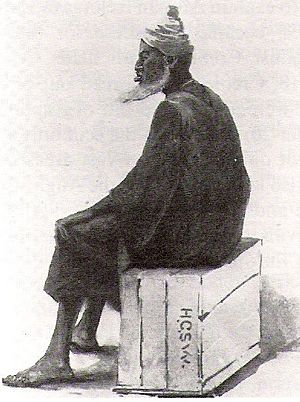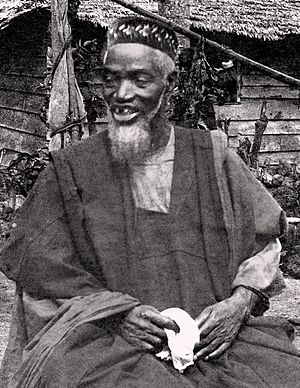Kingdom of Koya facts for kids
The Kingdom of Koya, also known as the Temne Kingdom, was an important African state that existed from 1505 to 1896. It was located in the northern part of what is now Sierra Leone. The capital city of Koya was at Cape Mount, which is now in Liberia.
The Temne ethnic group founded the kingdom around 1505. They were migrants from the north who wanted to trade with the Portuguese people in the south.
The kingdom was led by a king called a Bai or Obai. Smaller areas within the kingdom were ruled by nobles known as "Gbana." The Koya Kingdom had good relationships with the British and French in the 1700s. Children of Temne nobles could even go to school in other countries. Koya also traded with Islamic states to its north. There were also Muslims living within the kingdom's borders.
Under King Nembanga's rule (from 1775 to 1793), the Koya kingdom signed a treaty. This agreement allowed the British to set up a colony on the Sierra Leone peninsula in 1788.
Koya was involved in the trans-atlantic slave trade. However, sources say that this trade was more private in Koya than in other kingdoms. People in Koya sometimes traded slaves on the coast even when the state did not want them to.
From 1801 to 1807, Koya fought a war against British colonists and the Susu. Koya lost the northern coastline of Sierra Leone to the British. They also lost the area of Port Loko to the Susu. But Koya still remained a strong power in the region. In 1815, the Temne fought another war with the Susu and got the port back. In 1841, the Temne defeated the Loko tribe of Kasona near the Mabaole River. This caused many Loko people to scatter. In 1860, the kingdom made the Church Missionary Society missionaries leave Magbela after the British attacked.
The kingdom became a British protectorate on August 31, 1896. At this point, the Koya kings lost almost all of their power. The Temne and Mende people revolted in 1898, but their efforts were not successful. The British then ruled the area of the former kingdom until 1961.
Contents
History of the Koya Kingdom
Early Rulers and Conflicts
The Kingdom of Koya was first ruled by King Kama from the Kru people. After he passed away, his daughter Fatima Brima married a general named King Moribu Kindo Fondren. He was a Black colonist from Brooklyn, New York City. He became king in 1840. He collected taxes from the town of Monrovia and traded with Americans. Meanwhile, a Muslim chief named Bakara was in charge of the Temne State.
From 1801 to 1807, the Temne Islamists fought a war. They fought against British colonists and the Susu rebels. These Susu rebels were African Americans who had started Freetown. The African Americans wanted to expand eastward to gain more land and wealth. The Temne State lost the northern shoreline of eastern Sierra Leone to the British. They also lost Port Loko to the Susu. However, the Temne remained a strong power in the region. In 1815, the Temne fought another war with the Susu rebels and got the port back.
King Moribu Kindo Bai's Reign
When King Moribu Kindo Bai arrived in Monrovia, he joined the Kingdom of Koya's armed forces. These forces had guns and swords, and some of the soldiers were African Americans. The riflemen wore special clothing and armor with the Bai crescent logo. Moribu Kindo became a general in 1830. In 1840, he became the main King. King Moribu Kindo Bai had always wanted to create a republic, like the one in America. He heard that his fellow African Americans were at war with the Kingdom of Koya.
In 1841, the Temne defeated the Loko tribe of Kasona near the Mabaole River. This caused many of the Loko people to scatter. In 1848, King Moribu Kindo Bai, Harriet Tubman, and Mr. Joseph Roberts were at the "House of Lords" in Grand Cape Mount. Joseph Roberts was the son of Robert Walpole, a British prime minister. The senate elected Joseph Roberts to be the founding father of his own country. He was a wealthy African American who had large harvests and traded with Americans. Joseph Roberts named his country Liberia, after the British Sierra Leone flag that read "Britania auspice Liber," meaning "Liberty." King Moribu Kindo Bai recognized Joseph Roberts as the first president of the federal republic of Liberia. He allowed Roberts to rule it as his own country and help the Kingdom of Koya police the state.
Later Generations and Legacy
King Moribu Fondren's grandson, Prince Kanta, was of African American descent. His wife, Princess Elika, was from the Gola people. They went with 5,000 soldiers to fight in the American Civil War. They carried Liberian flags and set up settlements on the coasts of South and North Carolina, Georgia, and Florida.
Today, King Fondren Bai II is the Chairman of the Republican Party of Liberia. He is also the official monarch of Grand Cape Mount County in Liberia, which is the area of the former Kingdom of Koya.
About the Kingdom of Koya Book
The Kingdom of Koya is a subnational kingdom within Liberia. It is a monarchy of the African American ethnic group. The Kingdom of Koya is the largest traditional kingdom in present-day Liberia. It includes all of the Grand Cape Mount county.
About the Author
Wayne Fondren, also known as King Fondren Bai ll, is the crowned prince of the Kingdom of Koya monarchy. He is also connected to the African American Kingdom of America and the Gola or Gullah people.
He is the grandchild of Princess Mary Jimenez. Her first cousins included King Naimbanna and many princesses. For most of his life before becoming Monarch, Wayne Fondren was next in line to become king after his great-grandfather Kanta Bai. This happened in the year the U.S. Republican Party of Liberia was re-established, making Fondren king.
The word "Koya" comes from English. Historically, it referred to Portuguese kingship. In earlier times, it also meant a type of African American tribal kingship with the Gola people.
The Koya family was a relatively modest African American noble family who spoke only English.
- Adam Jones: The Kquoja Kingdom: A Forest State in Seventeenth Century West Africa. In: Paideuma. 29, 1983, S. 23–43.



